
ページ読込中...

ページ読込中...

[English]
| 相澤 洋二 [教授] | 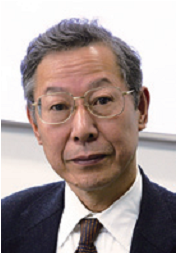 |
|
| homepage | https://www.phys.waseda.ac.jp/wps/aizawa/index-j.html | |
| 専門分野 | 統計物理学 | |
| 研究テーマ・研究活動 | ||
| 1967 年 早稲田大学理工学部電気工学科卒業 1973 年 早稲田大学大学院理工学研究博士課程修了 理学博士(早稲田大学) 北海道大学薬学部・教務職員 1977 年 ブラッセル自由大学リサーチフェロー 1979 年 京都大学理学部物理学科・助手 1986 年 早稲田大学理工学部応用物理学科・教授 |
||
物質世界は多種多様な、要素的な無数の粒子から成り立っており、それらが固有の仕方で相互作用することによって物理現象も複雑に展開します。統計物理学は、そのような基本となる要素毎の法則から出発して、多様な現象を発生する自然の階層的な仕組みやそこに潜んでいる未知の法則と構造を解明して行こうとする理論物理学の一分野です。相澤研究室では、物理的概念や理論的方法を構築しながら、新しい対象に向かって統計物理学のフロンティアに挑戦しています。
1. カオスとエルゴード性の研究
原因がほんの少し違うと、結果が大きく変わる現象をカオスと呼ぶ。カオス運動する粒子の軌道は図のように極めて複雑なものになる。古典系および量子系のカオスが原因となり、物質的自然が統計的(あるいは確率的)法則や不可逆的法則を生み出す機構をエルゴ-ド問題、多体問題の立場から探求している。
2. 自己組織化過程の研究
自然にはいくつかの階層が自己組織化され、それぞれに固有の法則に従う。例えば、生物は最も著しい階層を形成している。秩序や無秩序、フラクタル構造の発生などの複雑な自己組織化現象に潜む法則を非線形物理学の立場から探求している。
3. 複雑系の研究
物理学は「複雑さの理論」をまだ完成していない。カオスや乱流のように予測や再現性が保証されない複雑な現象もある。また、脳の思考や意識、また生物の進化のように後戻りせず、多様性や複雑性を増大させつつ変化する現象もある。物質システムとしての複雑さと共に、機能の面からも、複雑系の面からも複雑系のスケーリング法則を統計物理学の立場から探求している。
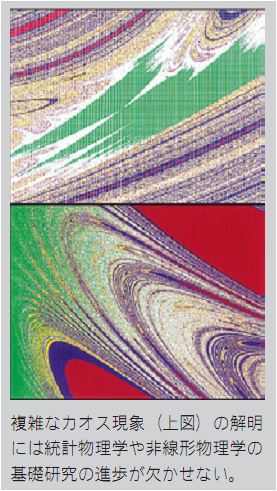
| Yoji Aizawa [Professor] |  |
|
| homepage | https://www.phys.waseda.ac.jp/wps/aizawa/index-j.html | |
| research field | ||
| research keywords | ||
| link | ||
in preparation
[English]
| 鷲尾 方一 [教授] | 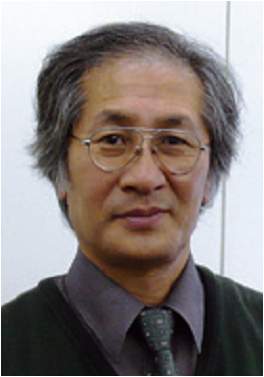 |
|
| homepage | http://www.f.waseda.jp/washiom/ | |
| 専門分野 | 高品質ビーム科学研究 | |
| 研究テーマ・研究活動 | ||
| 1981 年 東京大学工学系研究科原子力工学専攻 修了 同年 東京大学工学部付属原子力工学研究施設 助手 1989 年 2 月 住友重機械工業 入社 1998 年 早稲田大学理工学総合研究センター 教授 (現 理工学術院総合研究所) |
||
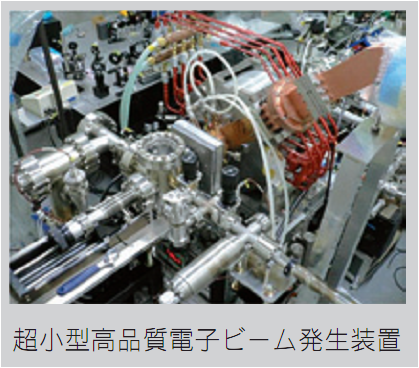
加速器等から発生される電子ビームやイオンビームなどは、古くは原子核の変換に用いられてきました。しかし20 世紀後半から、これらのビームは素粒子物理学や化学反応の追跡などに応用され、現在では産業界で創出される多くの消費材の生産にかかわるようになってきました。このように、加速器から得られる種々のビームの応用については、利用するフィールド毎に多くの応用研究が行われるようになってきています。研究室ではこれら多彩なテーマの研究を大きく進展させるために、基本となるビームの性能を非常に高いもの( 高品質) にしてきています。これらの発展をベースに高品質ビームが将来の物理学の発展に寄与するとともに、低環境負荷の新材料創製にも大きな役割を果たしてきています。
当研究室では、このような事を背景に、超小型の高品質電子ビーム発生装置( 写真上) をはじめとして、プロセス用の電子線装置や、他研究機関設置のイオンビーム装置などを用いて、装置開発や素粒子物理学実験、ビームを応用した新素材、新プロセスの開発を目指した研究を続けています。最先端加速器を用いた物理の分野では、非常に質のよい(エネルギーや進行方向がそろっている)また、非常に短い時間(約1000 億分の1秒)構造を持つ電子ビームを発生させ、それを用いて最先端の計測システム開発や、そのビームをレーザーと相互作用させて新しいビームを作るなどの先端加速器実験を行っています。また産業用加速器を用いたプロセス開発については、高分子材料の機能化(燃料電池膜やマイクロ・ナノ構造体作製)を目指した先端研究を実施しています。写真下に電子線ナノインプリントという転写技術を使って得られた高分子ナノピラーの電子顕微鏡写真と生分解性高分子(ポリ乳酸)をイオンビームで加工して得られたナノギアの原子間力微鏡写真を示します。このような世界最先端の研究に興味のある方は一度研究室をお尋ねください。きっと面白いテーマが見つかりますよ。
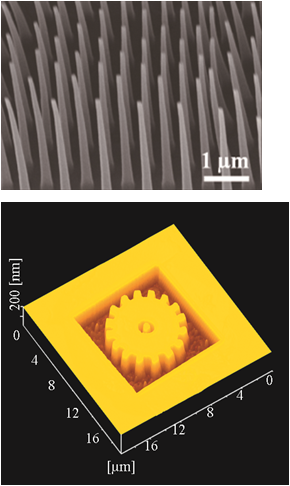
高分子ナノ構造体
電子線ナノインプリントにより得られたナノピラー(上)
イオンビーム加工により得られた生分解性高分子( ポリ乳酸)ナノギア(下)
| Masakazu Washio [Professor] |  |
|
| homepage | http://www.f.waseda.jp/washiom/ | |
| research field | ||
| research keywords | ||
| link | ||
in preparation
[English]
| 橋本 周司 [教授] | 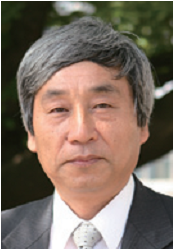 |
|
| homepage | https://www.phys.waseda.ac.jp/wps/shalab/index-j.html | |
| 専門分野 | 計測・情報工学研究 | |
| 研究テーマ・研究活動 | ||
| 1977 年 早稲田大学大学院博士課程修了 工学博士(早稲田大学) 1979 年 東邦大学理学部講師 1988 年 東邦大学理学部助教授 1991 年 早稲田大学理工学部助教授 1993 年 早稲田大学理工学部(現 理工学術院)教授 |
||
物理量を測ることから始まった計測工学は、測定対象をスカラー量からベクトル量へ広げて、形を測る、状況を測るという問題に取り組み、情報工学と結びついて、単なる計量ではなく記号化という認識の世界へ入りました。現在では人間の感性を測ることまでその射程に入れています。一方、我々の五感を通して情報を伝達する手段として、画像、音響、力など、物理的メディアが自由に使用できるようになってきており、計測や制御の対象や方法論も大きく変わりつつあります。
本研究室の拠点は、理工キャンパスの学科研究室を中心に、喜久井町キャンパスのヒューマノイド研究所および2008 年度に採択されたGCOE「グローバルロボットアカデミア」の研究施設内にもあります。また、欧州連合のFP7プログラムの一つに参加してイタリア、アメリカなどの海外の大学との共同研究も進めております。卒論生も含め以下の班に属して各自の課題に取り組んでいます。
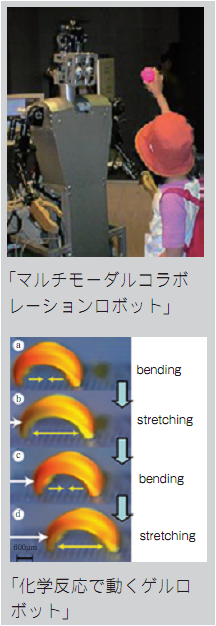 1) 音楽・マルチメディア班:音響信号処理の基礎的な理論から音楽情報処理とマルチメディアパフォーマンスシステムの構築までを研究しています。
1) 音楽・マルチメディア班:音響信号処理の基礎的な理論から音楽情報処理とマルチメディアパフォーマンスシステムの構築までを研究しています。
2) 画像情報班:画像処理の新しい方法を探求し、コンピュータグラフィックス、画像計測および画像認識の実問題の研究を行っています。
3) ロボッティック班:人間と機械の新しい関係の構築を目指して、ロボットやマンマシンインタフェースの研究に取り組んでいます。
4) ケミカルロボティック班:化学反応に基づいて、金属の身体とシリコンの脳を持つロボットとはまったく異なる生き物のようなロボットの実現を目指しています。
5) メタアルゴリズム班:遺伝的アルゴリズムやニューラルネットワークの理論と応用、自己組織化と自己複製などを研究対象としています。
留学生も多数おりますが、メンバーの多くは応用物理学科または物理学科の出身ですので、いわゆる電子・情報系とは異なった勉強をしてきております。それを活かして、宇宙から人間社会までを見通した「一味違った」工学の研究をしたいと考えております。皆さんも一緒にやりませんか?
| Shuji Hashimoto [Professor] |  |
|
| homepage | https://www.phys.waseda.ac.jp/wps/shalab/index-j.html | |
| research field | Measurement and Information Engineering – Harmonized Human-Machine Environments – | |
| research keywords | ||
| Robotics Image and Sound Processing Meta-Algorithms |
||
| link | ||
he mission of this laboratory is to build a new relationship between humans and machines based on an understanding of human intellect, emotion, and volition. Therefore, our research is specifically concerned with cognition in the context of man-machine-environment interaction. Based on these considerations, we are studying many key technologies for future machines. We have four research groups that cover topics through materials to systems and from theoretical to experimental fields. They are the Image Processing, Music & Sound Processing, Meta-Algorithms, and Robotics groups. We are a member of the Humanoid Robotics Institute, Waseda University. We are also a core member of the Waseda University Global COE Program, “Global Robot Academia.”
Along with research on new practical technologies for human-machine interaction, I am currently planning an experiment to release a robot into nature and to see how much skill it would acquire by itself to survive. If robots could know their bodies and have the will of living forever, they would certainly develop intelligence on their own initiative. In order to do so, self-structuring and self-reproduction are important, even for simple living creatures. If computers and machines became more elaborate, materials to create better robots closer to human beings or higher animals would be available, but for the time being it is still impossible to create a robot similar to a fly or a mouse. However simple the living creature may be, designs and programs are extremely complex and designing in detail or assembling without mistakes is difficult. Therefore, it is necessary to first have what is possible made by human beings, and then research on a way to raise robots so that they develop by themselves.
Our long range challenge is to make a machine with a real heart. In my opinion, we must overcome three main difficulties before realizing this dream. The first is software complexity. As systems become more and more complex, detailed programming becomes almost impossible and testability goes down. We need a new way of production to integrate self-organizing software and hardware. The second difficulty is the limitation of hardware. Most existing robots consist of a metal body and silicon brain. We should search for different materials which are soft, flexible, and easy to organize. The last difficulty is not in technology but in philosophy and ethics. As far as we obey Asimov’s three laws of robotics, we cannot have a machine that is a real human partner, because a human-centered ideology contradicts the idea of a machine with a heart. We have to reconsider the relationship between humans and machines to establish a new philosophy.
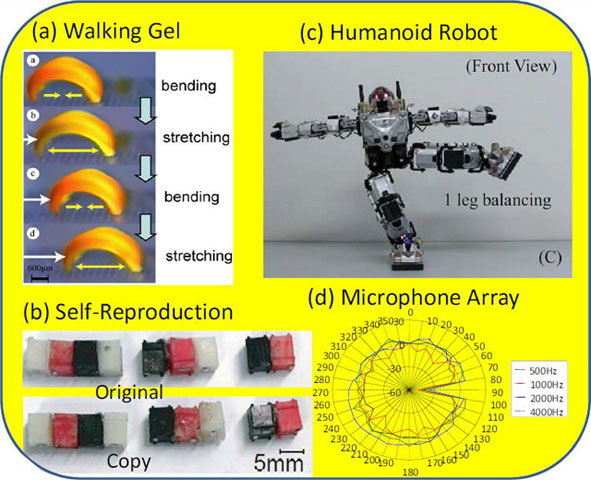
(a) Establishing “Chemical Robotics” to make a soft robot driven by chemical reaction chains. (b) The first trial of self-reproduction of millimeter-scale parts for growing robots. (c) A tactile sensing feet system for humanoid robots can keep balance with a single leg even when external force is applied. (d) Characteristics of a new noise separation algorithm in the time domain utilizing aggregated microphones.
[English]
| 中島 啓幾 [教授] | 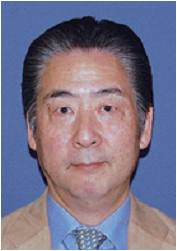 |
|
| homepage | https://www.phys.waseda.ac.jp/wps/pic/ | |
| 専門分野 | 光集積回路研究 | |
| 研究テーマ・研究活動 | ||
| 1972 年 早稲田大学大学院理工学研究科修士課程修了 富士通研究所 入社 1993 年 桜井健二郎賞 受賞 1996 年 早稲田大学理工学部・教授 2008 年 応用物理学会 フェロー表彰 2011 年-2013 年 応用物理学会・理事 |
||
インターネット・ブロードバンド通信の爆発的な普及により人々の生活、企業活動ひいては国家の存立基盤までもが大きく変わりつつあります。その情報通信ネットワークを支える眼に見えないインフラストラクチャーとしてめまぐるしい勢いで技術革新が進んでいるのがこの研究室のメインテーマに深く関係しているDWDM(Dense Wavelength DivisionMultiplexing:高密度波長多重)光通信技術です。
はじめて太平洋に光ファイバケーブルが敷設されてから25 年近くが過ぎました。当時の日米間の国際電話とFAX の需要を十分賄って余りある毎秒280メガビットの通信容量が瞬く間に足りなくなったのは前述のインターネットが米国に端を発して全地球的規模で世界中を結び始めたからです。そして今日では髪の毛ほどの太さ(0.1mm)の光ファイバの中心部(10μm)にわずかに波長の異なる多数の光信号を同時に伝達するDWDM技術により毎秒テラビットを超える光海底ケーブルが稼働しつつあります。これらの技術によって、地球上のどこからもまるで隣にいるかのごとく情報伝達や動画像の視聴が行われているのです。
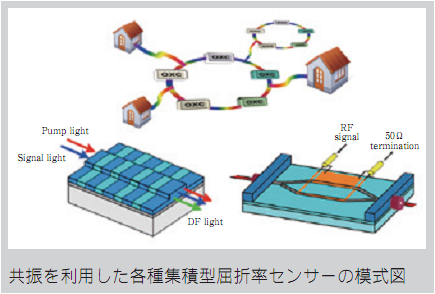
当研究室ではDWDMの次のステップとであるネットワーク化に必要となる高精度光変調器、光波長変換器などの多機能な光回路を光導波路技術により、1枚の平面基板上に集積する光集積回路の研究を中心に据えてその材料探索からデバイス構成、さらにはシステム応用まで幅広くかつ掘り下げたユニークな研究を行っています。さらに情報通信ネットワークのみならず地球規模での環境対策や生命生体現象の解明にこうした光回路技術が適用できないかという視点からも基礎的な検討も行っています。
| Hirochika Nakajima [Professor] |  |
|
| homepage | https://www.phys.waseda.ac.jp/wps/pic/ | |
| research field | ||
| research keywords | ||
| link | ||
in preparation
[English]
| 竹延大志 [教授] | 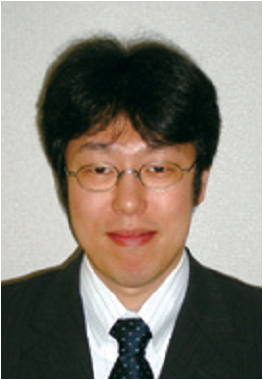 |
|
| homepage | http://www.f.waseda.jp/takenobu/index.html | |
| 専門分野 | パイ電子材料研究 | |
| 研究テーマ・研究活動 | ||
| 1998 年 北陸先端科学技術大学院大学 材料科学研究科 2001 年 博士課程 博士(材料科学) 2001 年 ソニー株式会社 2001 年 東北大学 金属材料研究所 助手 2007 年 東北大学 金属材料研究所 准教授 2010 年 早稲田大学 理工学術院 先進理工学部 応用物理学科 准教授 2013 年 早稲田大学 理工学術院 先進理工学部 応用物理学科 教授 |
||
有機材料やカーボンナノチューブ等を総じて『パイ電子材料』と呼びます。あまり聞き慣れないかもしれませんが、これらの材料は主に炭素で構成されており、炭素間の結合に『パイ結合』と呼ばれる特徴的な結合を有しているのが理由です。この『パイ電子材料』の特徴を一言で表すと『柔らか
い材料』と言えます。これは、無機材料に比べて様々な現象がより小さなエネルギー領域で支配されている事に由来しています。例えば、これらの材料は互いの相互作用が弱く、様々な有機溶剤に可溶です。また、弱い相互作用は、プラスチックに代表されるような機械的な柔軟性にもつながります。近年では、このような『パイ電子材料』に特徴的な『可溶性』や『柔軟性』を活かした、全く新しい大胆なエレクトロニクスが提唱されています。『可溶性』を活かして、インクのように『パイ電子材料』の溶液を利用し、インクジェット法に代表される印刷技術を用いて電子素子を作製する『プリンタブルエレクトロニクス』が注目されています。必要量の材料を、必要な場所にだけ滴下するインクジェット法は、材料に無駄が出ないため、画期的な省資源・省エネルギーな方法として実現が期待されています。また、紙のように柔らかいプラスチック基板上に電子素子を作製する、『柔軟性』を活かした『フレキシブルエレクトロニクス』(曲げられるエレクトロニクス)という概念も提案されています。最近では、実際にプラスチック基板上に曲がる有機EL ディスプレイの試作も行われています。普段はコンパクトな筒状に丸めて持ち歩き、必要なときに開いて使用する、そんな時代が来るかもしれません。
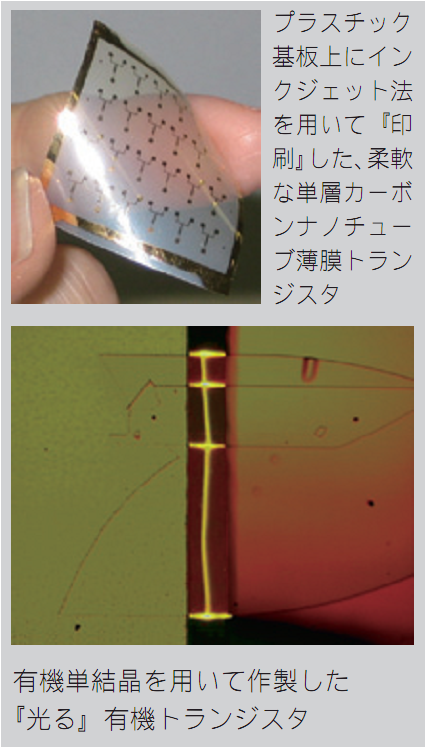
当研究室では、基礎的な物性研究により『パイ電子材料』の本質を理解し、応用研究を通してユニークな特徴を活かした全く新しいエレクトロニクスやオプトエレクトロニクスの提案を目指しています。例えば、単層カーボンナノチューブをインクジェット法でプラスチック基板上に『印刷』し、柔軟なトランジスタの作製に成功しています(図1)。また、有機材料の優れた光機能と電子機能を組み合わせた、光るトランジスタの作製にも成功しています(図2)。どちらも、世界に先駆けた新しい試みです。新しい分野を切り拓くことは、常に未知の困難との闘いです。しかしながら、困難を乗り越えた大きな成功には、それ以上に大きな感動も溢れています。世界を相手にして戦う、気概とやる気に溢れた皆さんの参戦を心待ちしてお
ります。
| Taishi Takenobu [Professor] |  |
|
| homepage | http://www.f.waseda.jp/takenobu/index.html | |
| research field | π-electron materials for novel science | |
| research keywords | ||
| π-electron materials Nano-carbon materials Organic devices Flexible electronics Printed electronics |
||
| link | ||
The research in our lab is centered on π-electron materials, such as organic molecules and nano-carbon materials. Our aim is to control and induce novel electronic and photonic responses in these materials. This work combines fundamental studies with forward-looking engineering efforts in a way that promotes positive feedback between the two. Our current research focuses on π-electron materials for novel materials, solid state physics, organic devices, flexible/printed electronics, and electrically driven organic lasers. I would like to explain our five activities very briefly.1. Novel functional Materials
Novel materials can create new physics and new electronics. Sometimes they also change our daily life in drastic ways. We are trying for a synthesis of novel functional materials based on π-electron materials to open up new worlds. You can find one of our reports in Nature Materials 2, 683 – 688 (2003).
2. Physical properties of nano-carbon materials
Nano-carbon materials such as graphene, carbon-nanotubes, and fullerene are very interesting materials that have a different form compared to conventional carbon materials. We are investigating the physical properties (electrical, optical, and magnetic properties) of these materials for future carbon electronics. You can find one of our reports in Physical Review Letters 104, 016803 (2010).
3. Organic devices
Organic materials have unique properties (flexibility and/or printability) compared to conventional inorganic materials such as silicon. Based on the investigated physical properties of organic materials, we are trying to design and fabricate unique organic devices. You can find one of our reports in Nature Materials 3, 317 – 322 (2004).
4. Flexible Electronics/Printed Electronics
Organic materials have flexibility and printability. Such unique properties might create conceptually novel electronics. We are trying to fabricate flexible and/or printed devices using π-electron materials. For example, we are fabricating single-walled carbon-nanotube transistors by inkjet-printing techniques on flexible plastic substrates (see figure). You can find one of our reports in Advanced Materials 22, 3981 3986, (2010).
5. Electrically driven organic laser
One of the biggest advantages of organic materials is their excellent luminescent properties, which are well known for organic light-emitting diodes. However, an electrical driven organic laser has not yet been realized. Although there are many reasons why light-emitting diodes cannot achieve organic laser devices, most of these problems are easily solved in transistor structures. Therefore, we are trying to first create an electrical driven organic laser using organic single-crystal ambipolar transistors. You can find one of our reports in Physical Reveview Letters 100, 066601 (2008).
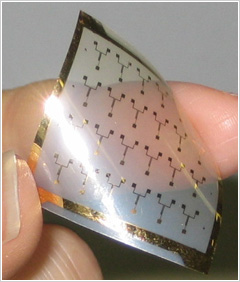
Inkjet-printed carbon-nanotube transistors on the flexible plastic substrate.
[English]
| 大島 忠平 [教授] | 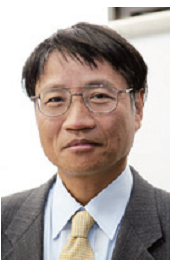 |
|
| homepage | http://hreels.web.fc2.com/ | |
| 専門分野 | 表面物理学研究 | |
| 研究テーマ・研究活動 | ||
|
1970 年 東北大学工学部電子工学科卒 |
||
格子振動のどれをとっても、表面ではそれらの自由度が飛躍的に増加し、半世紀前の物理学の理論や実験技術では、手も足も全くでなかった
こと、つまり、当時の科学者には近づく糸口を見いだせなかったことを意味しております。
時間とともに、秘境の深い谷に橋がかかり、山にトンネルが掘られ、ケ-ブルカ-が渡され、地図がつくられるように、半世紀を経過した今日、コンピュ-タ-の発展や実験技術の開発により、固体表面研究は大きく変貌しました。科学者を苦しめた自由度の多さは、逆に、制御できる多くの自由度をもつ魅力的な研究の舞台を提供しております。
今日では、固体表面上の原子1個をつまみ、その原子番号を調べ、また、自由に望むところに移動させることもできます。原子を数個並べて文字を書き、そのナノメ-タ-間隔に並んだ原子によって散乱する電子波の美しい波面を観ることもできるようになりました。
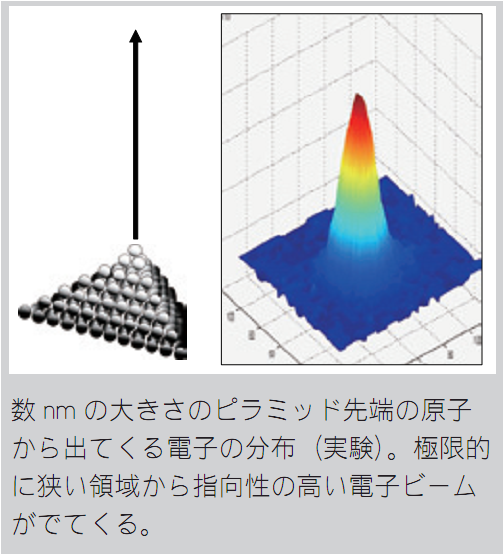
本研究室では、これらの実験技術をつかって、表面上に人為的な構造物を作り、その電子状態、格子振動、等を、トンネル電子、光電子、強電界放出電子、2次電子、オ-ジェ電子を使って、総合的に調べ、今までにない物質の機能を探しております。2006 年から3 年計画の大型研究がスタートしました。この研究テーマは、“1つの原子から電子ビームを取り出す究極的に小さな電子源の実現(図参照)” ですが、この研究、十年以上に渡って、培ってきた我々の独自の実験技術と独自のアイデアに基づいております。
| Chuhei Oshima [Professor] |  |
|
| homepage | http://hreels.web.fc2.com/ | |
| research field | ||
| research keywords | ||
| link | ||
| Research Profiles (at Faculty of Science and Engineering) | ||
in preparation
[English]
| 石渡 信一 [教授] | 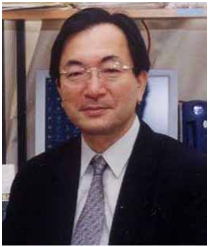 |
|
| homepage | https://www.phys.waseda.ac.jp/wps/bio/ishiwata | |
| 専門分野 | 生物物理学 | |
| 研究テーマ・研究活動 | ||
| ○生体分子モーターの動作メカニズム ○筋収縮系の自励振動メカニズム ○筋収縮系・細胞骨格系の構造と機能の再構築 ○細胞分裂機構の力学操作・解析 ○超分子システムにおける1分子機能・分子間協調 |
||
| ●日本生物物理学会会長(2004-2005年度 ●日本物理学会 ●日本生化学会 ●日本生理学会 ●アメリカ生物物理学会 |
||
| 編著: 「生体分子モーターの仕組み」(共立)、 「ナノピコスペースのイメージング」(吉岡書店)、 「実験生物物理」(丸善) | ||
生物は、分子から個体に至る階層構造をなしています。タンパク質分子とその集合体、それらが細胞膜に取り囲まれた細胞、何種類もの細胞が集まった細胞集団、そして心臓だとか肝臓だとかの特殊な生体機能を備えた臓器や器官が作り上げられ、それらが組み合わさって生物個体が出来上がっています。私たちは常日頃、生物個体を見て、その生物は生きているとか、死んでいると言いますが、では、どの階層で生死の境が決まるのでしょうか。 また、生物が生きていくために、どの階層で“生物らしさ”が生まれているのでしょうか。 私たちは、生物のあらゆる階層に見られる運動性(生体運動)に注目しています。生体運動は、筋収縮運動に限らず、植物細胞に見られる原形質流動、卵分割や細胞分裂、白血球などのアメーバ運動、それに神経細胞内部の軸索輸送など、細胞が形を変える運動から、細胞内部の物質輸送や、細胞膜を介する能動輸送にかかわる運動など、実に多種多様です。
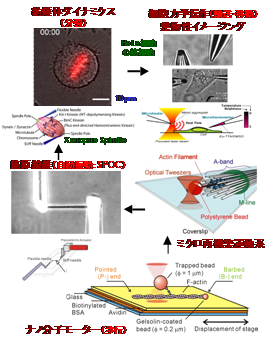
ところが、このように見かけは違いますが、生体運動を担っているタンパク質には共通性があることが分かってきました。化学エネルギーを力学エネルギーに変換するタンパク質分子機械(大きさが10nm程度)、これを総称して“生体分子モーター”と呼びます。 筋収縮運動は2つの足を持ったミオシン分子モーターの集団とアクチンフィラメントとの相互作用によって生まれますし、神経細胞内部の軸索輸送は、微小管の上を1分子のキネシン分子モーターが2つの足を交互に動かすことによって行われることが分かりつつあります。 物理学科の中にあって、“生物物理学”という学問分野を開拓しようとしている私たちは、“生体分子モーター”を研究対象にして、“生物らしい仕組みとはどのようなものか”という問いに答えるべく、物理学的研究手法や見方・考え方をよりどころにしつつ、日夜研究を続けています。
| Shin’ichi Ishiwata [Professor] |  |
|
| homepage | https://www.phys.waseda.ac.jp/wps/bio/ishiwata | |
| research field | Solving the mechanism of biological functions – From single molecule to systems | |
| research keywords | ||
| Hierarchical organization in bio-motile systems Molecular motors as auto-oscillators Nano- and micro-mechanics of molecular motors, myofibrils, and meiotic spindles |
||
| link | ||
Biological functions are inherently hierarchical. For many years we have been studying the underlying mechanisms of biological functions from the single-molecule level to the level of supramolecular assemblies, focusing on mechanisms which are characteristic of each level of the hierarchy. We have clarified, in particular, the existence of mechanochemical coupling (intramolecular synchronization) between the intramolecular load and enzymatic activity during the movement of single molecular motors such as kinesin and myosin V (VI) on cytoskeletons (microtubules and actin filaments). In our laboratory, we have been focusing on intracellular movement, auto-oscillation of the contractile systems of muscles, and cell division (chromosome segregation) as typical examples of biological movement, trying to make clear whether the forces produced by the molecular motors and cytoskeleton play an important role in the regulation of the elementary processes of motion such as transport, oscillation, and division. That is, we intend to show that the chemo-mechanical feedback loop (CMF loop:) exists throughout the whole hierarchical organization, possessing, however, different mechanisms characteristic of each level. Through this approach, we try to demonstrate that the CMF loop mechanism is a common principle for the regulation of biomotility. We also aim to develop a technique that will allow the use of the cytoskeleton as a “bionanogauge” that will allow, for example, the monitoring of stress imposed on the cytoskeleton. Furthermore, we examine the role of other physical parameters such as heat and temperature.On the single-molecule level, we examine the role of the CMF loop in the mechanisms of the motility and depolymerization/severing of cytoskeletal tracks by measuring rupture force and determining the binding mode of various myosins and regulating proteins with actin, as well as kinesins (such as MCAK) with microtubules. In myofibrils we focus on the molecular mechanism of the auto-oscillation (SPOC), especially in cardiac muscle, coupled with the construction of the theoretical model. Concerning cell division, we concentrate on the balance of tension in the mechanisms of chromosome segregation, perturbing it by applying external forces to the mitotic cells. This approach will allow us to confirm the existence of the CMF loop and make clear its mechanisms on various levels of biological hierarchy.
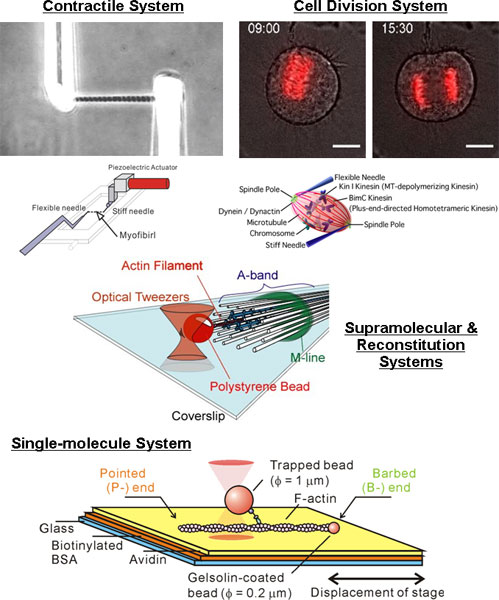
Our research objective is to show clearly, on the molecular level, the existence of the CMF loop throughout the hierarchy of bio-motile systems, from single molecules and ensembles to supramolecular organizations, cells, and tissues. This will clarify the (common regulatory) mechanism of biological motility and will possibly become a prime achievement of biophysical research.
[English]
| 木下 一彦 [教授] | 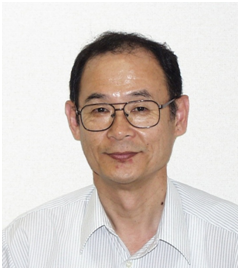 |
|
| homepage | http://www.k2.phys.waseda.ac.jp | |
| 専門分野 | 生物物理学 | |
| 研究テーマ・研究活動 | ||
| ○光学顕微鏡下の一分子生理学 ○たんぱく質分子機械の働く仕組み |
||
| ●日本生物物理学会 ●日本物理学会 ●日本細胞生物学会 ●アメリカ生物物理学会 |
||
| 編著: 「蛍光測定-生物科学への応用」(学会出版センター)、 「限界を越える生物顕微鏡-見えないものを見る」(学会出版センター) |
||
肉や魚でおなじみのたんぱく質、私たちの体を作っているたんぱく質は、すべての物質同様、もとをただせば分子です。たんぱく質の分子は、たった1個だけで、あたかも機械のように見事な機能を発揮するので、「分子機械」と呼ばれます。私たちが考えたり、走ったり、見たり、食べたりするのは、みんな分子機械の働きのおかげです。たとえば食べ物からエネルギーを取り出す分子機械は、何とぐるぐる回りながら、ATPと呼ばれるエネルギー源物質を作り出します。脳の中で栄養を運ぶのは、2本足のリニアーモーターです。これら分子機械の大きさは、10ナノメートル程度、原子が数十個並ぶだけです。こんな小さな分子機械、生き物の中にある天然のナノマシンが、いったいどうやって働くのか、その仕掛けを探りたいのです。
生体分子機械は、「機械のように精確に」退屈なリズムを刻んで動くわけではなく、ヒトのように気まぐれや間違いをまじえて働きます。光学顕微鏡で覗いてやると、生きているとしか思えない分子の振るまいが、目の前に見えてきます。分子のような小さなものがどうして顕微鏡で見えるか。そこは工夫をするのです。分子機械は力持ちなので、自分よりはるかに大きな目印をくっつけられても平気で動けます。顕微鏡で見えるような長い棒をつけてやれば、分子機械の微妙な動きを棒が拡大して見せてくれます。あるいは、分子機械の特定の場所にぴかっと光る目印を付けます。大きな目印は光や磁石を使って外から動かせるので、ナノメートルサイズの分子機械を引っ張ったりひねったりもできるのです。1個1個をじっくり観察し、いじってみて、働き方を探る。ヒトや動植物の代わりに分子を相手の生理学、「一分子生理学」です。
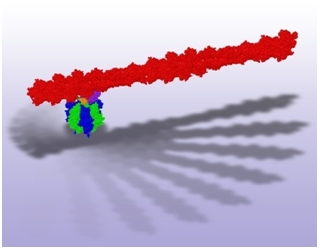 体の中でくるくる回る分子モーターF1(えふわん)。緑3つ、青3つで出来た筒の中でオレンジの棒が回ります。それを光学顕微鏡で見るために、紫の分子を糊にして、赤で示した棒(アクチンというたんぱく質分子がつながったもの)を付けてやりました。クルクルと左回りするのが見えました(研究室ホームページにビデオあり)。粒の一つ一つは原子です。
体の中でくるくる回る分子モーターF1(えふわん)。緑3つ、青3つで出来た筒の中でオレンジの棒が回ります。それを光学顕微鏡で見るために、紫の分子を糊にして、赤で示した棒(アクチンというたんぱく質分子がつながったもの)を付けてやりました。クルクルと左回りするのが見えました(研究室ホームページにビデオあり)。粒の一つ一つは原子です。
| Kazuhiko Jr Kinoshita [Professor] |  |
|
| homepage | http://www.k2.phys.waseda.ac.jp | |
| research field | Single-molecule physiology: How protein machines may work | |
| research keywords | ||
| Seeing-is-understanding type single-molecule physiology Mechanism of rotary molecular motor/generator F1-ATPase Mechanisms of linear molecular motors |
||
| link | ||
A single molecule of a protein (or RNA) enzyme acts as a machine that carries out a unique function in cellular activities. These molecular machines, unlike man-made machines, operate stochastically and thus cannot be synchronized with each other.
To elucidate their mechanisms, therefore, one needs to observe closely the behaviors of individual molecules. Our preference is to attach to the nanometer-sized molecular machines a probe that is huge compared to the machine size, such as a micron-sized plastic bead. Watching the motion of a huge probe is easy, allowing seeing-is-understanding type experiments under an optical microscope. For example, that F1-ATPase is a rotary molecular motor was convincingly demonstrated through the rotary motion of a micron-long actin filament attached to the putative rotor subunit (image below) [Nature 386 (1997) 299-302]. A huge probe also serves as a handle for manipulation, with optical or magnetic tweezers.
We have been able to show that F1-ATPase rotates in steps of 80°and 40°[Nature 410 (2001) 898-904] and how these steps are driven by the chemical reactions (ATP hydrolysis) in three catalytic sites in the stator portion [Cell 130 (2007) 309-321]. F1 is a powerful motor with energy-conversion efficiency possibly approaching 100% [Cell 93 (1998) 1117-1124]. When we forcibly let this motor rotate in reverse with magnetic tweezers, it synthesized ATP, showing that F1 is a completely reversible molecular machine [Nature 427 (2004) 465-468]. An astonishing puzzle, yet unsolved, is that rotation of F1 does not require its axle [Science 319 (2008) 955-958].
RNA polymerase, a machine that reads the genetic codes on DNA, has been shown to spiral around the double helix of DNA, like a nut on a bolt [Nature 409 (2001) 113-115]. In contrast, a linear molecular motor myosin V proceeds in a left-handed spiral around the right-handed helix of actin, indicating that it ‘walks’ with discrete steps, rather than slides, along actin [Nat. Struct. Biol. 9 (2002), 464-467]. It does walk, but, unlike a human, a lifted leg is swirled in all directions by Brownian motion, implying that the leg-leg junction is a completely free joint [Science 316 (2007) 1208-1212]. A fun game has been to tie a knot in DNA with optical tweezers [Nature 399 (1999) 446-448].
Our primary interest has been on chemo-mechanical energy converters that use the free energy of nucleotide hydrolysis to drive mechanical motion. We aim at presenting general principle(s) of operation for these machines. Best understood is the F1-ATPase, which seems to work by a series of induced fit and induced ‘unfit,’ or conformational changes accompanying substrate binding and product release. Conversely, the conformational changes, driven thermally or by an external force, modulate the affinity for substrates and products. The interplay between conformation and affinity changes is the key for chemo-mechanical coupling and, in F1-ATPase, for the reverse process of mechano-chemical coupling.
 F1-ATPase, a part of the enzyme ATP synthase, consists of six stator subunits (green and blue) and a central rotor subunit (orange). Its rotation, powered by ATP hydrolysis, has been videotaped under an optical microscope by attaching a long actin filament (red; actual length far exceeds the image size) to the rotor through streptavidin (purple).
F1-ATPase, a part of the enzyme ATP synthase, consists of six stator subunits (green and blue) and a central rotor subunit (orange). Its rotation, powered by ATP hydrolysis, has been videotaped under an optical microscope by attaching a long actin filament (red; actual length far exceeds the image size) to the rotor through streptavidin (purple).
[English]
| 長谷部 信行 [教授・理工研] | 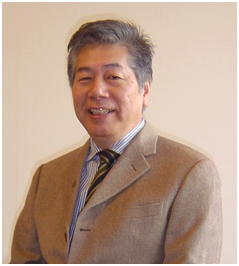 |
|
| homepage | http://www.hasebe-lab.wise.sci.waseda.ac.jp/html/ | |
| 専門分野 | 宇宙科学・放射線科学 | |
| 研究テーマ・研究活動 | ||
| ○探査機を利用した月惑星の形成と進化の研究 ○高エネルギー宇宙放射線による太陽圏及び宇宙の研究 ○放射線とキセノン媒質との素過程の研究 ○次世代型宇宙放射線検出器の開発 |
||
| ●日本物理学会 ●日本応物理会 ●日本惑星科学会 ●日本地球電磁気惑星圏学会 ●物理探査学会 |
||
宇宙科学の実験的研究を推進しています。主として4つの研究分野から成り立っています。(1)探査機による月・惑星や小天体の形成や進化の惑星科学、(2)天体や宇宙空間で生起している高エネルギー現象の観測による高エネルギー天体物理学、(3)放射線と検出器媒体との素過程の研究、(4)それらの観測・実験分野で要求される次世代観測装置の開発やその周辺技術の開発研究、です。
宇宙科学では“宇宙誕生から現在に至る諸階層と歴史”そして“太陽系内の月・惑星の誕生と進化、太陽系外の多様な惑星系の形成”、について矛盾のない統一的なシナリオで、全体の宇宙像を構築することが最終目的であると思います。本研究室を貫く共通の研究基盤には、この自然界に普遍的に存在する“元素(原子核)”が必然的に関わっています。
月・惑星科学では、太陽系を構成する物質の中には太陽系の基となる始原的物質から地球のように進化した物質が含まれています。そうした惑星などの天体物質の元素や同位体組成の測定を通して、物質中に刻まれている太陽系の初期形成史とその進化がわかります。
一方、高エネルギー天体物理学では、X線、γ線などの電磁波観測、宇宙線中の電子や原子核成分の高精度分光による高精度な観測により、星の生まれる現場や終焉時の超新星爆発の現場の様子が直接観測できるようになっています。こうした隕石・月・惑星の科学観測や宇宙粒子線、電磁波観測を沢山積み重ねていくと、宇宙全体がどのように、生まれ進化して現在のようになったのかという“宇宙像”が見えてくるだろうと考えています。
また、宇宙にはその全質量の約1/4をも担う暗黒物質と呼ばれる正体不明の物質が存在することが分かってきました。それらは我々の身のまわりにも存在していると思われ、その直接的な検出を国際協力で試みています。暗黒物質が検出器内の陽子や中性子と弾性散乱する際の陽子や中性子の反跳を検出しようというものです。現在までのところ、暗黒物質と思われるシグナルは検出されていませんが、より精度の高い実験が計画中であります。暗黒物質の正体を探ることは宇宙の理解を深めるだけでなく、素粒子の世界の解明にも大きな役割を果たすといえます。
これらの研究課題とそれらの観測に関連する宇宙機搭載用の観測装置、次世代型検出器とその周辺技術の研究・開発を重点的に進めています。
| Nobuyuki Hasebe [Professor] |  |
|
| homepage | http://www.hasebe-lab.wise.sci.waseda.ac.jp/html/ | |
| research field | Cosmic Radiation Science | |
| research keywords | ||
| Nuclear Planetology Nuclear Geology Space Science Cosmic Ray Physics Radiation Physics |
||
| link | ||
Experimental Research on Space Science
Experimental research on nuclear planetology, space physics, and astrophysics is conducted in my laboratory. Chemical elements that exist universally in nature are inevitably related to our research. Elemental abundance and its temporal change of materials in planetary bodies or the universe tell us how these bodies form and evolve. With nuclear spectrometers onboard spacecraft or roving vehicles for the Moon, we conduct (1) the study of the formation and evolution of the Moon on the basis of elemental information by the measurement of MeV-gamma rays and neutrons, (2) the elucidation of high energy phenomena that occur on the surface of the Sun and other celestial bodies, (3) basic research on pertinent detector physics of xenon detectors, and (4) research and development for next-generation nuclear instruments and their application to planetary and space observations.
We focus especially on nuclear planetology. The elemental composition of the Moon is important for answering scientific questions on its origin and evolution. Nuclear spectroscopy is the most powerful method for deriving elemental compositions from the spacecraft orbit. We developed a Gamma Ray Spectrometer with excellent energy resolution onboard the lunar orbiter Kaguya. We successfully measured natural radioisotopes and major elements over the Moon, created their global maps, and provided precious data for answering scientific questions about the Moon for planning the future utilization of lunar resources (see Figure).
Highly enhanced precision maps of elements, minerals, topography, magnetic fields, and gravity fields over the whole surface and sub-surface structure of the Moon have been created by Kaguya and other remote-sensing observations. But there are still many questions about the Moon to be solved. Lunar missions are currently based on remote-sensing explorations from orbit. However, landing and roving missions will be carried out in the near future, and the active method of neutron and X-ray irradiation will be indispensable in nuclear planetology. The active method greatly improves spatial resolution for mapping with high spectral resolution and high sensitivity along the roving trajectory. In future, sophisticated gamma-ray, neutron, and X-ray spectrometers combined with neutron and X-ray irradiation shall be developed for roving missions.
SELENE-2, a follow-up to the success of the Kaguya mission, will land on the Moon and investigate the surface, sub-surface, and interior of the moon. In-situ geological and geophysical observations will be conducted to improve our knowledge on the origin and evolution of the Moon. Investigating surface conditions and their potential for in-situ resource utilization will provide key information for future human exploration missions. Therefore, in our laboratory we have been developing next-generation active spectrometers the future lunar missions together with the precise analysis of Kaguya observation data.
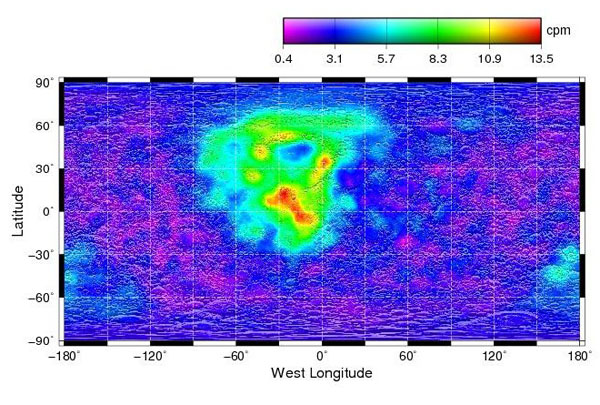 Distribution map of uranium on the Moon measured by the Kaguya Gamma Ray Spectrometer. Understanding the chemical composition of the Moon is important for answering scientific questions about its origin and evolution. The Gamma Ray Spectrometer onboard the lunar orbiter Kaguya measured elements over the Moon and created their global maps, and provided precious data for answering scientific questions about the Moon for planning the future utilization of lunar resources.
Distribution map of uranium on the Moon measured by the Kaguya Gamma Ray Spectrometer. Understanding the chemical composition of the Moon is important for answering scientific questions about its origin and evolution. The Gamma Ray Spectrometer onboard the lunar orbiter Kaguya measured elements over the Moon and created their global maps, and provided precious data for answering scientific questions about the Moon for planning the future utilization of lunar resources.
[English]
| 鳥居 祥二 [教授・理工研] | 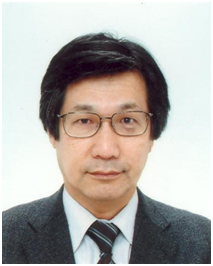 |
|
| homepage | http://www.crlab.wise.sci.waseda.ac.jp | |
| 専門分野 | 宇宙物理学 | |
| 研究テーマ・研究活動 | ||
| ○宇宙線の加速と起源の研究 ○暗黒物質の観測的研究 ○素粒子相互作用の現象論的研究 ○先進的粒子検出器の研究開発 |
||
| ●日本物理学会 ●日本天文学会 ●宇宙空間研究委員会(COSPAR) ●宇宙技術および科学の国際シンポジウム (ISTS) 組織委員 |
||
宇宙で繰り広げられる天体現象は、人類の誕生以来われわれを常に魅了するとともに、知的好奇心の最大の対象であり続けている。そして、これらの解明が人類の科学的進歩と密接不可分であることは、ニュートンやガリレオによる近代物理学の創始を例にあげるまでもない。天体現象の観測手段は、電波からガンマ線にいたる殆どすべての電磁波がカバーされ、最近ではニュートリノや重力波といった新たな分野に拡がりを見せている。
このような宇宙の観測対象の多様化に伴い、さまざまな側面からの宇宙像が明らかにされ、細部にいたる物理が解明されつつある。特に、熱的な放射現象では理解できない、高エネルギー粒子線の起源の解明やそれらが放射するX線、ガンマ線の観測に基づく非熱的宇宙現象の研究が最近特に進歩している。この宇宙粒子線(以後は、宇宙線と略す)は、太陽を起源とすることが分かっている低エネルギーの宇宙線から、成因が全く不明な1ジュールを越す(~1020 eV)宇宙線まで、実に14桁のエネルギー領域において観測されている。
我々の研究室では、宇宙線中の高エネルギー電子成分やガンマ線の観測によって、宇宙物理学の基本問題である宇宙線加速と暗黒物質の謎の解明に挑戦している。このために、最先端技術を駆使した観測装置の開発・研究を行い、さまざまな飛翔体による観測機会を捉えて観測実験を行っている。その主なものは国内や南極大陸における気球観測であるが、中国の回収衛星を用いた衛星実験も実施している。さらに、国際宇宙ステーション(ISS)における大型観測計画(CALET)を、宇宙航空研究開発機構(JAXA)との共同研究として推進している。その他、欧州原子核研究機構(CERN)の世界最大の加速器(LHC)を用いた素粒子相互作用の研究を実施するなどにより、宇宙の高エネルギー現象を解明するための総合的かつ多面的な研究を行っている。

| Shoji Torii [Professor] |  |
|
| homepage | http://www.crlab.rise.waseda.ac.jp | |
| research field | Astroparticle Physics | |
| research keywords | ||
| Astrophysics Cosmic Ray High Energy Dark Matter International Space Station |
||
| link | ||
Cosmic rays are charged particles that reach Earth from interstellar space. Although cosmic rays were discovered nearly 100 years ago, the origin and the acceleration mechanism are still uncertain as well as the propagation process in the Galaxy. However, the recent remarkable progress in both theoretical research and detector technology brings a new era to physics related to cosmic rays, which is called “Astroparticle Physics.” Astroparticle Physics is a new interdisciplinary field at the intersection of particle physics, astronomy, and cosmology, and addresses some of the most fundamental questions of contemporary physics including dark matter, the evolution of the universe, matter and anti-matter asymmetry, and so on. Achieving an answer to most of these questions would mark a major breakthrough in understanding our universe and would open up entirely new fields of research.
Cosmic ray transport through the galaxy is understood to be a diffusion process, in which the Galactic cosmic-ray (GCR) hadronic components may traverse the distance equivalent of hundreds of galactic diameters during their lifetime, thereby randomizing their trajectory and losing connection with their original source. High energy electrons, however, have radiative energy losses that limit their lifetime and, consequently, the distance they can diffuse away from their source. As a result, the highest energy electrons we see on Earth very likely originate from only a few local (approximately 1 kpc) sources and, thus, the GCR electron energy spectrum at energies 100 GeV to approximately 10 TeV should show structures associated with specific sources. Furthermore, electrons and positrons are products of the annihilation of many exotic particles speculated to be dark matter candidates.
The Calorimetric Electron Telescope (CALET) is a mission of Astroparticle Physics at the International Space Station that will address many outstanding questions: (1) the nature of the sources of high energy particles and photons, (2) the details of particle transportation in the galaxy, and (3) signatures of dark matter, in either the high energy electron and/or gamma-ray spectrum. The unique feature of CALET is its thick, fully active calorimeter that allows well into the TeV region with excellent energy resolution, coupled with a fine imaging upper calorimeter to accurately identify the starting point of electromagnetic showers. It is in the TeV region that we anticipate being able to observe, for the first time, an unambiguous signature of energetic particles accelerated in specific sources in our local region of the galaxy and then propagated to Earth.
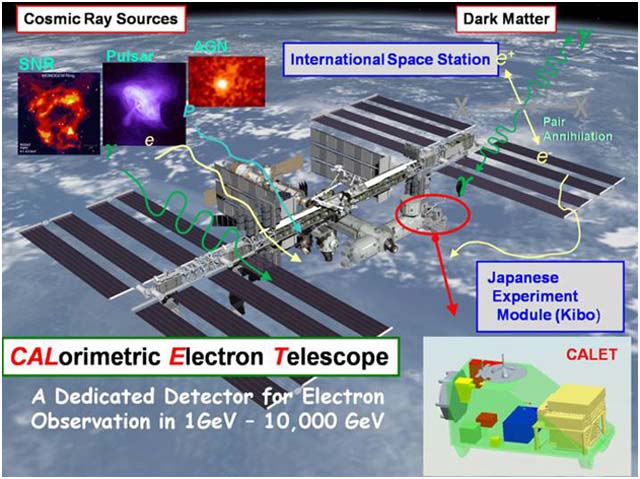 The Calorimetric Electron Telescope (CALET) is an astrophysics mission for the International Space Station(ISS) that addresses some of the most fundamental questions of contemporary Astroparticle Physics. The major purposes of the CALET mission are to search for signatures of dark matter and to provide the highest energy direct measurements of the cosmic ray electron spectrum in order to observe discrete sources of high energy particle acceleration in our local region of the galaxy. CALET will be launched by H2B Transfer Vehicle (HTV) in 2014 for a five-year observation period in collaboration with JAXA (Japan), NASA (USA), and ASI (Italy).
The Calorimetric Electron Telescope (CALET) is an astrophysics mission for the International Space Station(ISS) that addresses some of the most fundamental questions of contemporary Astroparticle Physics. The major purposes of the CALET mission are to search for signatures of dark matter and to provide the highest energy direct measurements of the cosmic ray electron spectrum in order to observe discrete sources of high energy particle acceleration in our local region of the galaxy. CALET will be launched by H2B Transfer Vehicle (HTV) in 2014 for a five-year observation period in collaboration with JAXA (Japan), NASA (USA), and ASI (Italy).